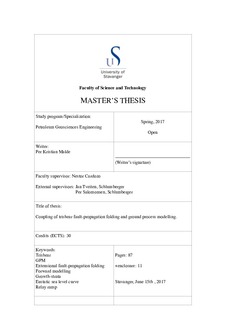Coupling of trishear fault-propagation folding and ground process modelling.
Master thesis
Permanent lenke
http://hdl.handle.net/11250/2464462Utgivelsesdato
2017-06-15Metadata
Vis full innførselSamlinger
Sammendrag
This thesis couples two processes, tectonics and sedimentation, by simulating the kinematics of fault-propagation folding with sedimentary processes in the form of erosion, transport, and deposition, in a 3D numerical forward tectono-sedimentary model. This model couples two programs: trishear (Erslev, 1991; Cardozo, 2008) as Matlab scripts for the kinematic simulation of fault propagation folding, and GPM a Petrel plugin for ground process modelling (Tetzlaff et al., 2014). A link between these two programs was established, to send results and communicate during the simulation. The dynamic relationship between tectonics and sedimentary processes is well illustrated in the models presented, which are divided in two cases: i. A single normal fault propagating with various trishear parameters along strike, or with constant trishear parameters and various GPM parameters. ii. An extensional relay ramp, first, with an overall slope controlled diffusion process, then with an unsteady flow process simulating turbidites. Trishear kinematics combined with GPM simulates a forward physical depositional environment where the sedimentary processes accommodate the tectonic response in a realistic manner. Thus, growthstrata geometries combined with tectonic deformation are significantly influenced by tectonic uplift and sea level changes, resulting in distinct system tracts. Since the model is embedded in Petrel, visualisation of the resultant depositional geometries, either as cross sections or Wheeler diagrams, is straightforward. The potential for further developing this implementation is significant, either by further elaborating the tectonic or sedimentary models (e.g. compressional folds, salt tectonics, carbonates depostion), or by post-processing the model results for fluid flow or seismic response.
Beskrivelse
Master's thesis in Petroleum Geoscience Engineering

